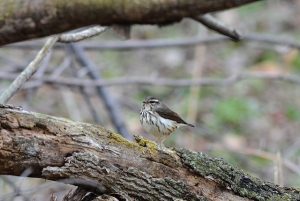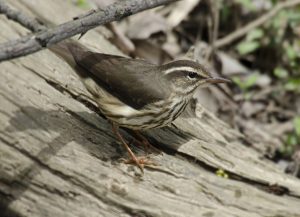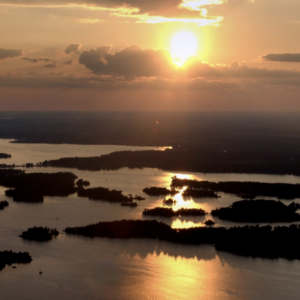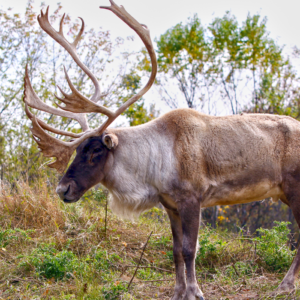A brush with the Louisiana Waterthrush
This blog is written by guest blogger Eric Davidson.
While the Louisiana Waterthrush closely resembles a thrush, it’s actually a warbler. You can recognize this small bird by its dusty brown and white feathers, pink legs and always-bobbing tail.
The Louisiana Waterthrush’s habit of living along moving streams and rivers as well as their distinctive call, with the first notes of its song falling in pitch, set the bird apart from the Northern Waterthrush. The Northern Waterthrush prefers swamps and bogs, and its calls keep the same pitch.
The early bird gets the worm
The Louisiana Waterthrush makes a presence in Southern Ontario known with loud, ringing chirps. It gets there early in the spring before most other birds have arrived. Unlike many of its fellow warblers, the male Louisiana Waterthrush doesn’t sing at its wintering ground before leaving, but bursts into song when it arrives at its summer breeding territory.
And it’s not just after worms. The Louisiana Waterthrush likes to feed on insects like beetles and ants, as well as dragonflies, crustaceans, snails, small fish and seeds.
Home is where the heat is
While some Louisiana Waterthrushes make regular summer stops in southern Ontario, most live south of the border. There are between 105 and 195 pairs of the species in Canada, less than one percent of the global population, which is around 360,000. Belying its name one again, the Louisiana Waterthrush can be found from Maine, Indiana and Minnesota, to Nabraska and Kansas, down to Texas, Georgia and North Carolina.
To the envy of most Canadians, the Louisiana Waterthrush spends its winters in warm weather in the West Indies, Mexico and Central and South America.
 Conservation
Conservation
Deforestation and habit loss have caused the number of Louisiana Woodthrush to drop over the past few years. The bird is currently protected under the federal Species at Risk Act (SARA) and the Migratory Birds Convention Act. Environment Canada has released a plan to maintain the species by encouraging conservation of breeding sites and cooperation with international bodies like Partners in Flight.
Fun Facts
- The Louisiana Waterthrush sometimes takes naps in the middle of the day—birds need a break too!
- The oldest known Louisiana Waterthrush was at least 11 years old, while the average lifespan for the birds is eight years.
- The Louisiana Watherthrush’s distinct, bobbing walk is noted in its genus, Motacilla, which means “wagtail” in Latin.
- The Louisiana Waterthrush is a quick eater, performing up to 10 feeding maneuvers per minute.
- A group of warblers can be called a “bouquet”, “confusion”, “fall”, or “wrench”.
To learn more about the Louisiana Waterthrush, check out our Endangered Species Profile!
Acknowledgments: All About Birds, What Bird, Animal Diversity Web and Widescreen Arkive.



